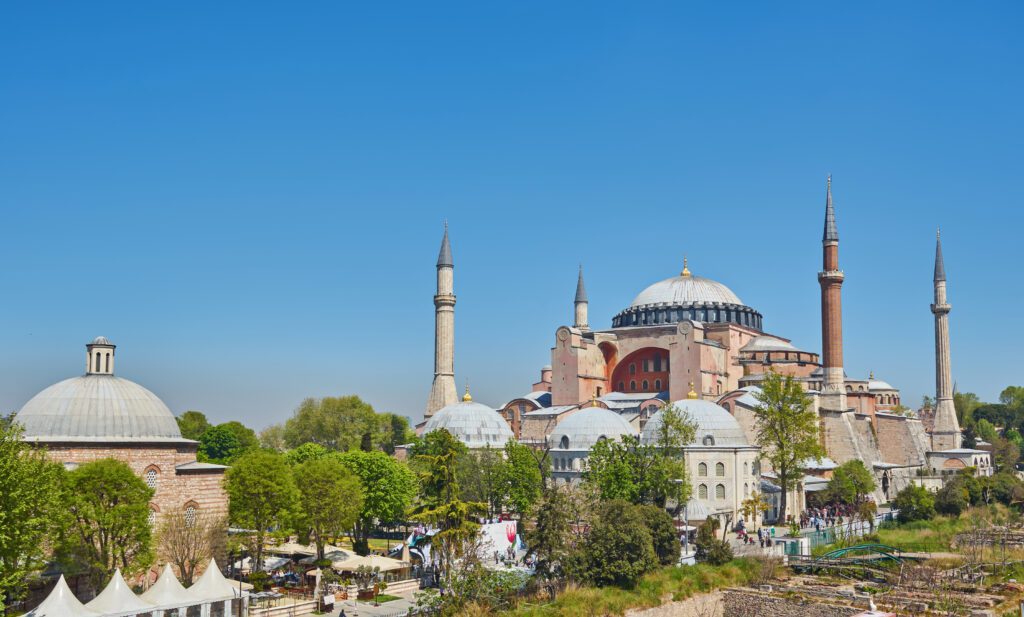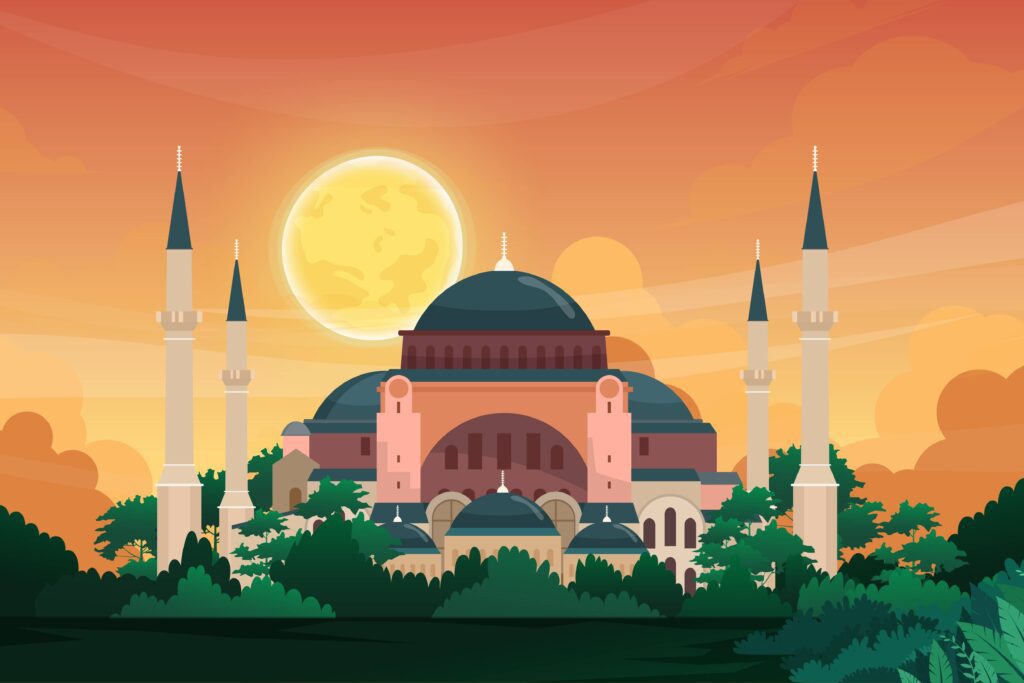Embark on a captivating journey with “The Ultimate Guide: The Enchanting Hagia Sophia – Definition, Tips, and Iconic Interior.” Discover Istanbul’s historic gem, Hagia Sophia, as we unveil its rich history, architectural marvels, and cultural allure. Unravel the essence of “Holy Wisdom,” explore the fusion of Byzantine Christian and Islamic influences, and find essential tips for an unforgettable visit. Join us as we step into a world of grandeur and splendor, immersing ourselves in the timeless charm of Hagia Sophia.
Table of Contents
The Ultimate Guide: The enchanting Hagia Sophia
The Ultimate Guide to Enchanting Hagia Sophia: Unveil Istanbul’s Timeless Icon, Its Fascinating History, and Wonders of 2023–24 Explore Awe-Inspiring Beauty!

What is the definition of Hagia Sophia?
Hagia Sophia, known as Ayasofya in Turkish, is an iconic building in Istanbul, Turkey. Originally a cathedral, then a mosque, then a museum and now a mosque “Hagia Sophia” means “Holy Wisdom” in Greek. Its historical and architectural significance lies in its blend of Byzantine Christian and Islamic elements, showcased through its grand dome and intricate mosaics. A symbol of Istanbul’s rich heritage and a major tourist attraction.
How do you pronounce Hagia Sophia?
Hagia: Pronounce the first part as “HAH-yuh.” The “H” is pronounced like the English “h” sound, and “AH” is a short “a” sound, as in “cat.” Sophia: Pronounce the second part as “so-FEE-uh.” The “so” part is pronounced as “so,” and “fee” sounds like “fee” in “feeble,” and the “uh” at the end is a short “a” sound, like in “cat.” Putting it together, you get “HAH-yuh so-FEE-uh” when pronounced in English.
Is there a dress code for Hagia Sophia?
Certainly! There is a dress code for Hagia Sophia, and visitors must follow the guidelines when entering the iconic historical site. It requires dressing modestly, which means covering your shoulders and knees. The important thing, visitors show respect for the sacredness of the place and acknowledge its cultural significance.
What to wear to Hagia Sophia
Choose comfy, loose clothes that cover shoulders, arms, and legs. Bring a scarf, if needed, for your head. Avoid tricky-to-remove sandals or shoes. Socks keep feet clean and safe. Stay cozy and respectful during your visit!

Do you need tickets for Hagia Sophia?
Previously, a museum entrance fee was mandatory for Hagia Sophia. However, now it’s free to visit. Tickets are unnecessary. Respectfully, avoid visiting during prayer times to avoid disturbing worshippers.
Tips for visiting the Hagia Sophia
1: Dress modestly, As mentioned earlier, dress respectfully and modestly, covering your shoulders and knees to show respect for the sacredness of the site.
2: Check Opening Hours: Before visiting, check the opening hours of Hagia Sophia to plan your trip accordingly.
3: Arrive Early: To avoid large crowds and long lines, consider arriving early in the morning.
4: Bring a Scarf or Shawl: If you’re visiting as a woman, it’s helpful to have a scarf or shawl to cover your head inside the mosque area.
5: Respect Prayer Times: If you happen to visit during prayer times, be mindful of the worshippers and avoid entering the mosque area while prayers are ongoing.
6: Take Guided Tours: Consider joining a guided tour to get a deeper understanding of the historical and cultural significance of Hagia Sophia.
7: Photography Rules: Check the photography rules before taking pictures inside, as some areas might be restricted from photography.
8: Stay Hydrated: Istanbul can get hot during certain times of the year, so carry water to stay hydrated during your visit.
9: Explore Surrounding Areas: After visiting Hagia Sophia, take some time to explore the other attractions nearby, like the Blue Mosque and Topkapi Palace.
10: Enjoy the Experience: Lastly, take your time to soak in the beauty and history of Hagia Sophia, and enjoy your visit to this remarkable and iconic landmark.
Christ Pantocrator (Pandokrator) Hagia Sophia
In Hagia Sophia, the Christ Pantocrator is a significant religious mosaic located on the main dome’s interior surface. It portrays Jesus Christ as the Almighty Ruler, or “Pantocrator” in Greek. The mosaic depicts Christ with a serious expression, holding a book (often a Gospel) in one hand and making a blessing gesture with the other. This powerful representation of Jesus as the ultimate authority and judge holds great religious and artistic significance and is an important symbol within the history of Hagia Sophia as a former church and mosque, now a museum.

Hagia Sophia icons
The term “Hagia Sophia icons” refers to the religious artworks and paintings that embellish the majestic interior of Istanbul’s historic Hagia Sophia. Originally an Eastern Orthodox cathedral adorned with Byzantine Christian icons, frescoes, and mosaics depicting Christ, the Virgin Mary, saints, and biblical scenes. After Ottoman rule, it became a mosque, covering some Christian icons and adding Islamic elements like calligraphy. In 1935, it became a museum, uncovering and preserving ancient Christian artworks. Today, visitors witness a blend of Christian and Islamic art, a testament to Istanbul’s religious and cultural heritage.
Hagia Sophia opening hours
The current schedule for visiting the Hagia Sophia, as of 2023, extends from 9:00 in the morning until 22:00 in the late evening. However, being a functioning mosque, it partially restricts tourist visits during prayer hours. In July 2023, the Hagia Sophia won’t completely close during prayers but will remain accessible to visitors every day. To explore this iconic mosque, ensure your visit falls outside the designated prayer times.
Hagia Sophia interior
The Hagia Sophia interior is a mesmerizing sight inside the historic building in Istanbul, Turkey. Adorned with stunning mosaics, it reflects the blend of Byzantine Christian and Islamic influences. A captivating symbol of cultural richness and architectural brilliance.

Hagia Sophia floor plan
The Hagia Sophia floor plan illustrates the layout of this iconic building in Istanbul, Turkey. It showcases the vast central dome, the main prayer hall, and multiple galleries. The design incorporates a fusion of Byzantine and Islamic architectural elements, reflecting its diverse history as a cathedral and mosque. A testament to engineering ingenuity and historical significance.
Conclusion
Hagia Sophia, the iconic building in Istanbul, Turkey, holds immense historical and architectural significance as a symbol of cultural richness. Originally a cathedral, then a mosque, and now a museum, it beautifully combines Byzantine Christian and Islamic elements. Visitors must follow the dress code, covering shoulders and knees, to respect its sacredness. While tickets are no longer required, arriving early and taking guided tours enhance the experience. The Christ Pantocrator mosaic and Hagia Sophia icons are powerful religious artworks reflecting their diverse heritage. With its mesmerizing interior and remarkable floor plan, Hagia Sophia remains an awe-inspiring testament to human ingenuity and cultural history. If you want to learn more about Turkey’s destination, please click the link.
